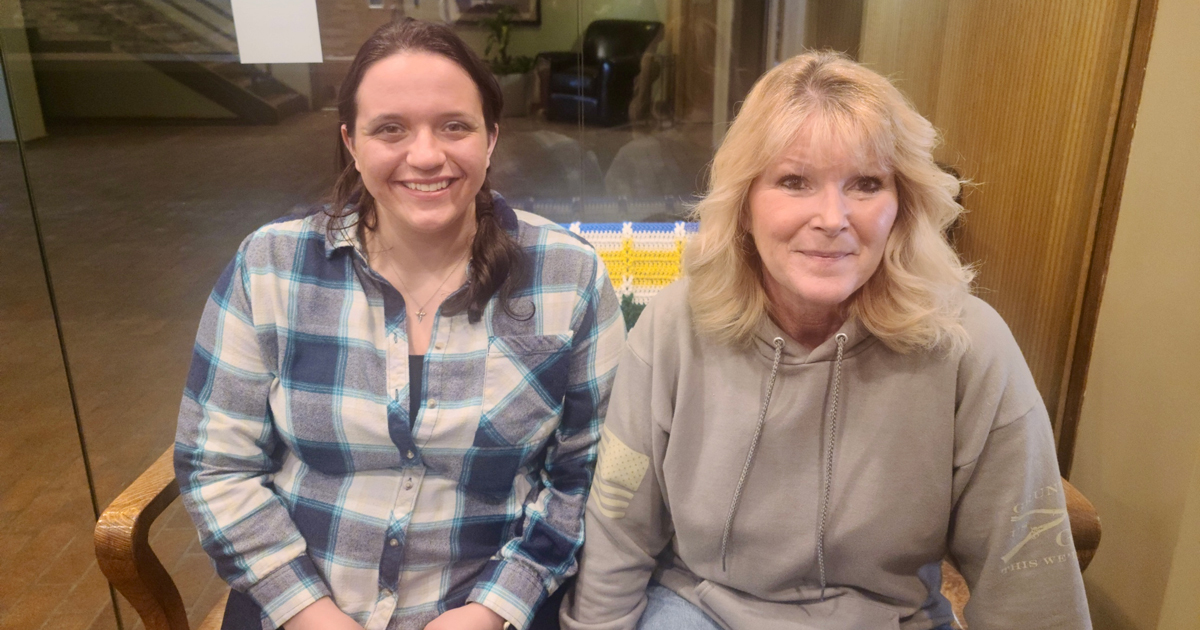Patient survives serious stroke due to quick response of co-worker and stroke team

You've probably heard it said before: When it comes to stroke, a quick response is critical.
Quick action may have saved Terri Willenborg's life.
At 54 years old, with no risk factors or family history, Willenborg never dreamed that she would suffer a stroke. That was something that happened to old people. But not always, as Willenborg found out. It started as a normal day at work. Willenborg felt perfectly fine. She was in her office when co-worker Amy Koperski entered to ask a question. Upon entering, Koperski noticed that Willenborg was acting strangely.
"She seemed to be staring down blankly at her desk," recalls Koperski. "When I asked her to look up at me, her face was drooping, and she wasn't moving her left arm. I asked her to grab my hand with her right hand and then her left hand, but she still couldn't move her left arm." Koperski, who had some medical aid training and experience in the past, says she knew immediately what was happening.
"I tried to stay calm," says Koperski. "I called out to another co-worker for help and asked her to call 911."
Willenborg was taken by ambulance to Nebraska Medical Center where she was immediately given a clot-busting medicine (tPA). Just 25 minutes had passed since her initial symptoms. tPA should be given within three hours of the first symptoms to be effective.
A CT scan was then taken that showed a clot had escaped from a damaged carotid artery. Willenborg had experienced an ischemic stroke, which involves a narrowing or blockage in the arteries to the brain. One of the most severe forms of stroke, Willenborg's situation was critical.
"A large portion of the brain is at risk for permanent damage if the artery isn't opened quickly," says Daniel Surdell, MD, Nebraska Medicine endovascular neurosurgeon. "This type of stroke can also lead to brain swelling, making it difficult to survive."
The Nebraska Medicine stroke team was ready. They prepared Willenborg for emergency surgery. Dr. Surdell performed a procedure called mechanical thrombectomy to remove the clot and reopen flow to the brain.
Mechanical thrombectomy is performed by threading a catheter through the femoral artery to the site of the clot. The stent is used to remove the clot, thus allowing the blood flow to be restored to the brain, preventing large areas of the brain from dying.
Blood flow was restored, and Willenborg was allowed to go home several days later with anti-platelet medications. Unfortunately, less than two weeks later, Willenborg suffered a second stroke. Again, she went to the Nebraska Medical Center for emergency surgery. This time a stent was placed in the artery over the damaged area.
"Whenever possible, we like to avoid putting a stent in a young person like Terri, as the artery will heal on its own in more than 50% of cases," explains Dr. Surdell.
Willenborg underwent two weeks of rehabilitation after the stroke and continues to take blood thinners.
"It all happened incredibly fast, and due to the efficiency of everyone, I have minimal residual side effects and am doing very well," says Willenborg. "I cannot say enough about the excellent care I received at Nebraska Medical Center. Everyone from the neurology team to the ER staff to the nursing staff and the lovely lady who brought me breakfast – they were absolutely fabulous.
"All things considered, I am very pleased with my inpatient care as well as the follow-up care I have received from Nebraska Medicine. If there is anything I have taken away from my experience, it is that the faster you get treatment, the better the odds of a full recovery."
Dr. Surdell concurs. "Time is critical when it comes to stroke. The sooner you can get to a comprehensive stroke center like Nebraska Medical Center, the better your chances
are of minimizing brain damage and side effects of stroke."
Nebraska Medicine has the only nationally certified stroke center in the region, with a stroke team that provides 24/7 care of stroke patients using a well-defined, systematic approach to care and treatment to achieve optimal results. Historically, patients who are treated within a few hours of an acute stroke using specialized treatments and medications at the hands of a dedicated and coordinated team of physicians and health care providers experience the most positive outcomes.
"We have a system in place that allows us to work as efficiently as possible and provide the most comprehensive care so that patients get the appropriate diagnosis and the best outcomes," says Dr. Surdell. "We have multiple layers of health care providers in place who have all received stroke training and have a critical role to play."
When a patient arrives in the ED who is suspected of having a stroke, the stroke team is notified and deployed. "It is the knowledge and expertise of each person on our team that makes this process the best it can be from the nurses and doctors who assess the patient in the Emergency Department (ED) to the CT technicians and radiologists and our dedicated stroke team," he says.
Stroke is the third leading cause of death in this country. Nearly 800,000 people suffer a stroke each year and approximately 1 out of 6 of these people will die from the stroke.
"I look back on it now and it feels surreal," says Koperski. "It was a miracle. People work in their offices all day long and may not talk to someone else for hours. I'm glad I was in the right place at the right time."
Thanks to the quick actions of Koperski, and the rapid diagnosis and decisions made by the Nebraska Medicine stroke team, Willenborg is a survivor.






